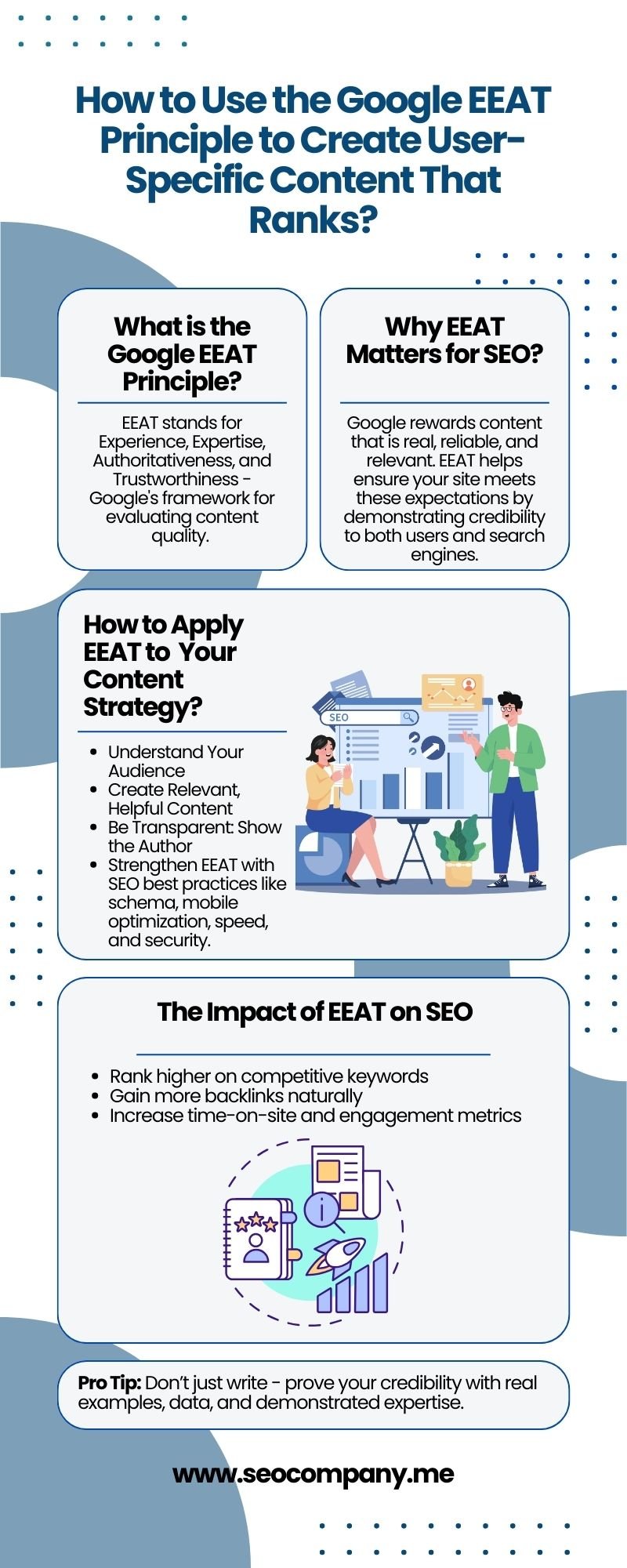Suppose you’ve ever wondered why some websites consistently rank high on Google while others struggle to be seen, despite having decent content. In that case, the answer often lies in one robust framework: the Google EEAT Principle.
Whether you’re a blogger, business owner, or digital marketer, understanding and applying EEAT can greatly improve the performance of your content.
In this blog, we’ll explore what EEAT means, why it matters more than ever in 2025, and how to use it to create content that truly speaks to your users—and ranks well on Google.
What is the Google EEAT Principle?
EEAT stands for:
- Experience
- Expertise
- Authoritativeness
- Trustworthiness
It’s part of Google’s Search Quality Evaluator Guidelines, which assess whether a piece of content is high-quality and deserves to rank.
Initially introduced as E-A-T in 2014 and expanded to E-E-A-T in 2022 (adding “Experience”), the principle is now at the core of how Google determines content quality.
Why Is the Google EEAT Principle Important?
Think of it this way: Google’s mission is to organise and make the world’s information universally accessible and helpful. To do that, it wants to show users the most reliable, credible, and valuable content.
If your content demonstrates EEAT, you’re telling Google:
“I know what I’m talking about.”
“I have real experience in this topic.”
“You can trust the information I provide.”
Question: Does your content reflect your first-hand experience, industry expertise, and authority in your niche?
Breaking Down the EEAT Components (With Examples)
1. Experience
This refers to the first-hand involvement of the content creator with the subject.
Example: A tutor writing about “How to Prepare for the PSLE English Exam” based on years of teaching experience.
Tip: Add personal stories, case studies, or results to showcase lived experience.
2. Expertise
This is about the knowledge or skill in a specific field or topic.
Example: A certified financial planner writing a guide on student loan strategies.
Tip: Use credentials, professional background, or formal training to reinforce expertise.
3. Authoritativeness
This measures how reliable your brand or website is within your niche.
Example: An established education platform has authority because it’s widely cited and trusted.
Tip: Build backlinks from reputable sources, and encourage mentions from industry influencers or academic institutions.
4. Trustworthiness
The most crucial part is how safe and accurate your content is.
Example: Secure website (HTTPS), transparent privacy policies, and citing credible sources increase trustworthiness.
Tip: Always fact-check your data and include external links to government or academic sites where relevant.
How to Apply the Google EEAT Principle to Create User-Specific Content
Now that we understand EEAT, how do we apply it?
Know Your Audience First
Creating user-specific content means understanding your audience’s:
- Pain points
- Intent (informational, transactional, navigational)
- Level of knowledge
Interactive Prompt: Have you built user personas or surveyed your audience lately?
Craft High-Quality, Relevant Content
Google rewards depth and specificity. Don’t write for everyone—write for your exact user.
- Use the user’s language (not technical jargon unless appropriate).
- Include visuals, data, or interactive tools to make content more engaging.
- Update old content to stay current and factually accurate.
Showcase Your Credentials & Credibility
Use author bios, “About Us” pages, or trust badges to reinforce authority.
Examples:
“Written by John Tan, MOE-registered tutor with 12 years of experience”
“Featured on Channel News Asia, The Straits Times, and The Smart Local”
Use Structured Data and SEO Best Practices
- Use schema markup for articles, authors, and FAQs.
- Optimise meta titles and descriptions (like this blog’s!).
- Keep mobile-friendliness and page speed in check.
The Impact of EEAT on SEO in 2025 and Beyond
Google’s algorithm updates are increasingly prioritising content quality over quantity. Sites that score well on EEAT metrics tend to:
- Rank higher on competitive keywords
- Gain more backlinks naturally
- Increase time-on-site and engagement metrics
EEAT is not optional; it’s essential, especially for YMYL (Your Money or Your Life) content, such as education, healthcare, or finance.
Final Thoughts: EEAT Is the Foundation of Sustainable SEO
SEO isn’t about tricking the algorithm anymore—it’s about proving your worth and delivering real value to users.
By aligning your content with the Google EEAT Principle, you:
- Build trust with your audience
- Enhance your search visibility
- Future-proof your content from major algorithm updates
So ask yourself: Is your content demonstrating real experience, expertise, and trust? If not, it’s time to rethink your strategy.
Need Help Optimising Your Content for EEAT?
At SEOCompany.me, we specialize in helping businesses—especially in the education and service sectors—build content that Google and users love.
From content strategy to technical SEO, we tailor your growth using EEAT best practices.
Contact us today for a free content audit and actionable advice to improve your rankings.
Author
-
An experienced Content Writer and SEO Analyst with a strong background in crafting high-quality blogs, articles, social media posts, and website content. With over five years of expertise, she specializes in creating engaging, optimized content that enhances visibility and drives organic traffic. Her deep understanding of SEO, keyword strategies, and content marketing helps brands establish a strong digital presence. Passionate about digital marketing, she stays ahead of industry trends to deliver impactful and results-driven content.
View all posts
 Baby Rani
Baby Rani




